| Marginalia |
The ongoing Marginalia series of large–scale limited edition archival pigment prints begins with rare books and manuscripts on subjects having to do with the history of art, astronomy, physics, religion and other subjects, after which high–resolution scans of selected title and text pages are acquired. In some cases, data–derived imagery from spacecraft and orbiting telescopes are also employed. Added texts and/or painterly intervention/commentary to the images refer to marginalia (the timeless practice of writing in book's page margins, such that the page content is amplified), and are drawn from my own writings/visuals and the writings of various individuals in history.
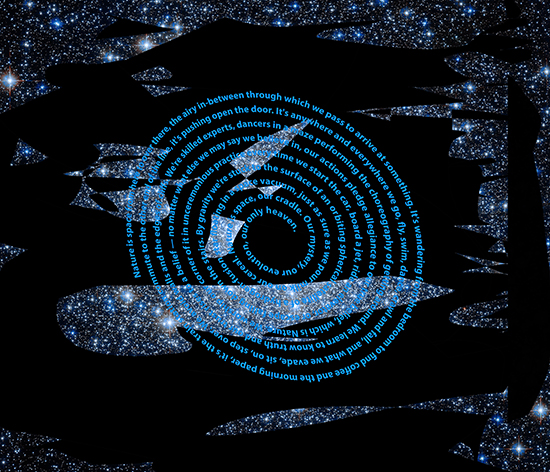
Marginalia (Our Only Heaven), 2023
Text: Stephen Nowlin essay excerpt, Realspace, 2017.
Image: James Webb Telescope, Globular Cluster M92 (NIRCam Image)
Original data and processing: NASA, ESA, CSA, Alyssa Pagan (STScI)
Archival pigment print, 62 x 74 inches (mounted).
Marginalia text:
NATURE is space from here to over there, the airy in-between through which we pass to arrive at something. It's wandering from the bedroom to find coffee and the morning paper, it's the train station commute to the other end of the line, it's pushing open the door. It's anywhere and everywhere we go, fly, swim, dance, crawl and fall — and what we evade, sit on, step over. We avoid walls and the edges of cliffs. We're skilled experts, dancers in a maze performing the choreography of getting around. We learn to know truth and our trust rises to a belief — no matter what else we may say we believe in, our actions pledge allegiance to our true belief, which is Nature. We worship our corner of it in unceremonious practice every time we start the car, board a jet, ride an elevator, or escape falling down the stairs. By gravity we're stuck to the surface of an orbiting spherical satellite of a hydrogen-fusion star floating in a space vacuum, just as sure as we pour milk on our cereal. Nature is space, our cradle. Our mystery, our evolution, our only heaven.
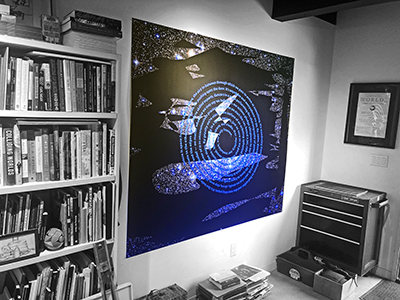
Detail
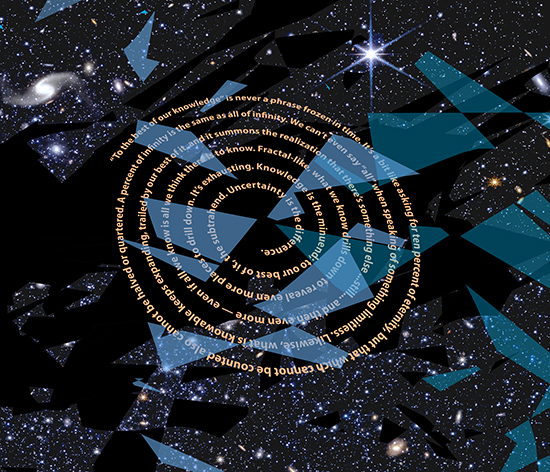
Marginalia (Uncertainty), 2023
Text: Stephen Nowlin essay excerpt, Uncertainty, 2016.
Image: Webb Telescope, stars and galaxies outside the Milky Way
Original data and processing: NASA, ESA, CSA, Kristen McQuinn, Zolt G. Levay
Archival pigment print, 62 x 74 inches (mounted).
Marginalia text:
“To the best of our knowledge” is never a phrase frozen in time. It's a bit like asking for ten percent of eternity, but that which cannot be counted also cannot be halved or quartered. A percent of infinity is the same as all of infinity. We can't even say “all,” really, when speaking of something limitless. Likewise, what is knowable keeps expanding, trailed by our best of it, and it summons the realization that there's something else ...still... and then even more — even if all we know is all we think there is to know. Fractal–like, what we know drills down to reveal more places to drill down. It's exhausting. Knowledge is the minuend; to our best of it, the subtrahend. Uncertainty is the difference.
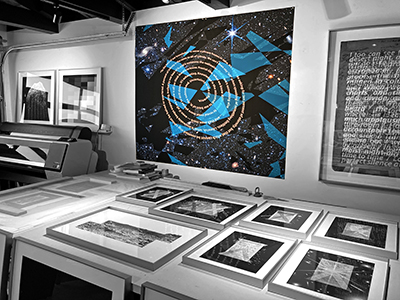
detail

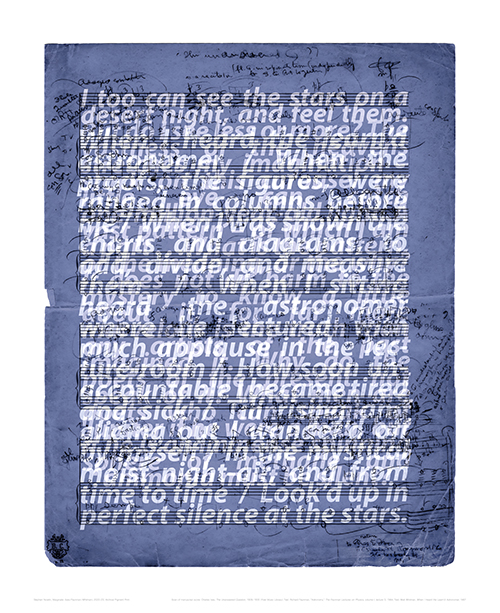
Marginalia (Ives/Feynman/Whitman), 2022-23; Archival Pigment Print
Superimposed Elements:
Scan of manuscript score: Charles Ives, The Unanswered Question, 1908/1935 (Source, Yale Music Library);
Text: Richard Feynman, “Astronomy,” The Feynman Lectures on Physics, volume I; lecture 3, 1964;
Text: Walt Whitman, When I Heard the Learn'd Astronomer, 1867.
46 x 37 inches (framed)
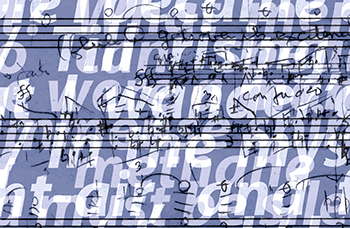
detail
Charles Ives manuscript:
American composer Charles Ives (1874-1954) wrote the score for The Unanswered Question, a six–minute orchestral piece celebrating the perennial human quest for knowledge, in 1908. It was updated and finally performed, three decades later.
Embracing similar sensations of cosmic mystery nearly a half–century earlier in 1867, Walt Whitman wrote his sublime poem When I Heard the Learn'd Astronomer that, however, implied an unfavorable comparison between the dull mechanics of science and the enthrallments of personal transcendent experience. One–hundred years after Whitman, the Nobel Prize physicist Richard Feynman synthesized the poet's transcendentalism and the composer's majestic curiosity, proposing that mystery and profound sensation awaits us not only in romanticizing physical matter, but equally in pursuing knowledge of it.
Whitman text:
When I heard the learn'd astronomer / When the proofs, the figures, were ranged in columns before me / When I was shown the charts and diagrams, to add, divide, and measure them / When I sitting heard the astronomer where he lectured with much applause in the lecture–room / How soon unaccountable I became tired and sick / Till rising and gliding out I wander'd off by myself / In the mystical moist night–air, and from time to time / Look'd up in perfect silence at the stars.
Feynman text:
Poets say science takes away from the beauty of the stars — mere globs of gas atoms. I too can see the stars on a desert night, and feel them. But do I see less or more? The vastness of the heavens stretches my imagination — stuck on this carousel my little eye can catch one–million–year–old light. A vast pattern — of which I am a part . . .What is the pattern, or the meaning, or the why? It does not do harm to the mystery to know a little about it, for far more marvelous is the truth than any artists of the past imagined it. Why do the poets of the present not speak of it? What men are poets who can speak of Jupiter if he were a man, but if he is an immense spinning sphere of methane and ammonia must be silent?
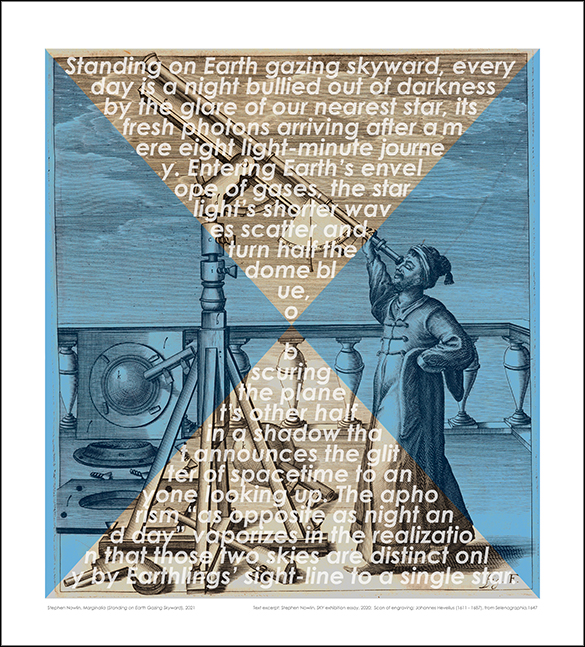
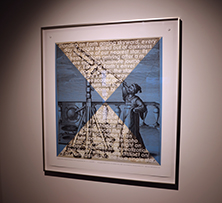
Marginalia (Standing on Earth Gazing Skyward), 2021; archival pigment print, limited edition, 28x31 inches.
Text excerpt: Stephen Nowlin, SKY exhibition essay, 2020;
Scan of engraving: Johannes Hevelius, (1611-1687), from Selenographia, 1647.
Marginalia text:
Standing on Earth gazing skyward, every day is a night bullied out of darkness by the glare of our nearest star, its fresh photons arriving after a mere eight light–minute journey. Entering Earth's envelope of gases, the starlight's shorter waves scatter and turn half the dome blue, obscuring the planet's other half in a shadow that announces the glitter of spacetime to anyone looking up. The aphorism “as opposite as night and day” vaporizes in the realization that those two skies are distinct only by Earthlings' sight–line to a single star.
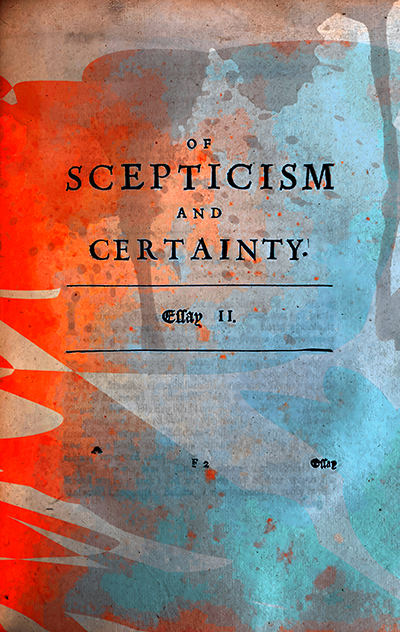
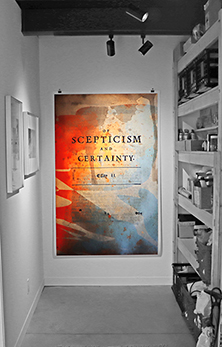
Marginalia: Of Scepticism and Certainty, Essay II, 2022
Image: scan of chapter heading page from Essays on Several Important
Subjects in Philosophy and Religion, 1676, by Joseph Glanvill (1636-1680).
Archival pigment print, 66.5 x 42 inches (mounted).
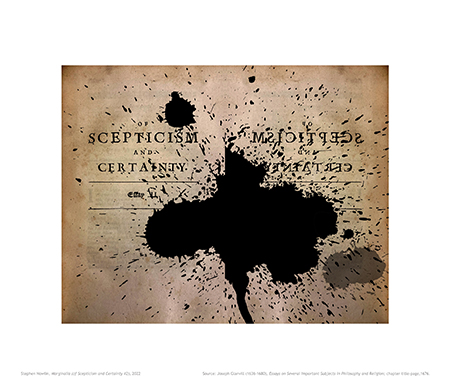
Marginalia: Of Scepticism and Certainty #2, 2022
Image: scan of chapter heading page from Essays on Several Important
Subjects in Philosophy and Religion, 1676, by Joseph Glanvill (1636-1680).
Archival pigment print, 22.5 x 27.5 inches (framed).
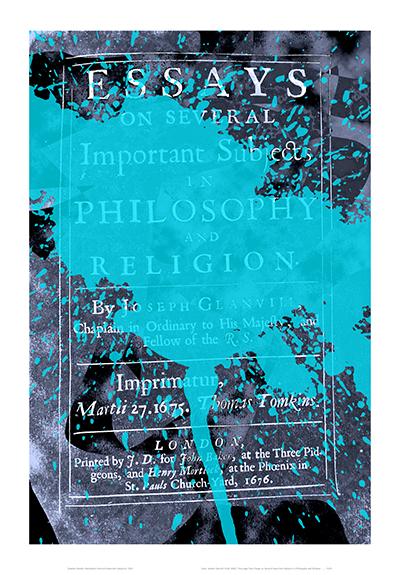
Marginalia (Several Important Subjects), 2023
Image: scan title page Essays on Several Important
Subjects in Philosophy and Religion, 1676, by Joseph Glanvill (1636-1680).
Archival pigment print, 46 x 32 inches (framed).

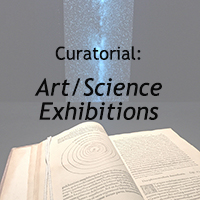
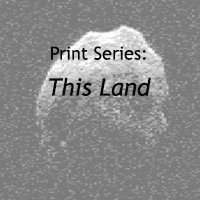
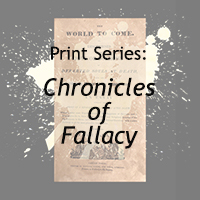
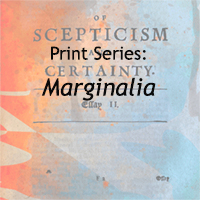
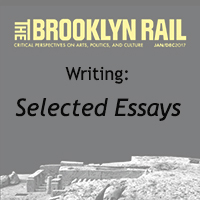
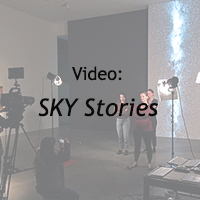
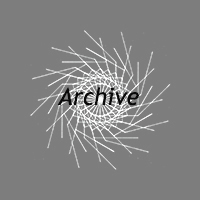
stephen at stephennowlin dot com

